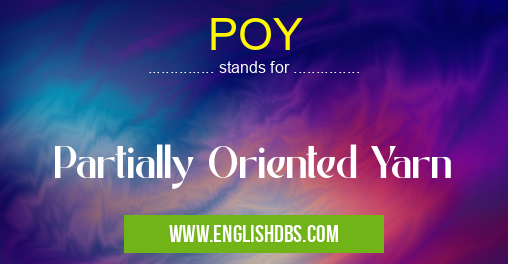What does POY mean in UNCLASSIFIED
Partially Oriented Yarn (POY) is a type of textile yarn that undergoes partial orientation, a process that enhances its molecular structure and improves its physical properties. This process involves stretching the yarn under controlled conditions, resulting in improved strength, stability, and resistance to shrinkage.

POY meaning in Unclassified in Miscellaneous
POY mostly used in an acronym Unclassified in Category Miscellaneous that means Partially Oriented Yarn
Shorthand: POY,
Full Form: Partially Oriented Yarn
For more information of "Partially Oriented Yarn", see the section below.
Characteristics of POY
- Improved Strength: The partial orientation process aligns the molecular chains within the yarn, enhancing its tensile strength.
- Increased Stability: POY exhibits reduced shrinkage and elongation compared to conventional yarns, making it more dimensionally stable.
- Enhanced Durability: The aligned molecular structure provides greater resistance to abrasion and wear, prolonging the life of the fabric.
Applications of POY
POY finds wide application in various textile industries, including:
- Apparel: Used in clothing, sportswear, and activewear for its durability and shape retention.
- Home Textiles: Suitable for upholstery, curtains, and bed linens due to its resistance to fading and shrinkage.
- Industrial Fabrics: Utilized in applications such as conveyor belts, hoses, and protective clothing thanks to its exceptional strength and stability.
Essential Questions and Answers on Partially Oriented Yarn in "MISCELLANEOUS»UNFILED"
What is Partially Oriented Yarn (POY)?
Partially Oriented Yarn (POY) is a type of synthetic yarn that has undergone a specific manufacturing process called partial orientation. This process involves stretching the yarn under tension, which aligns the polymer chains and improves the yarn's strength, modulus, and dimensional stability. POY is typically used as a precursor for producing fully drawn yarn (FDY), which has even higher strength and orientation.
What are the advantages of using POY?
POY offers several advantages over non-oriented yarns, including:
- Improved strength: The partial orientation process increases the strength and durability of the yarn, making it more resistant to breakage and tearing.
- Enhanced modulus: POY has a higher modulus than non-oriented yarns, which means it is more rigid and less likely to stretch or deform under load.
- Increased dimensional stability: The alignment of the polymer chains in POY reduces shrinkage and distortion, resulting in better dimensional stability.
How is POY used in the textile industry?
POY is primarily used as an intermediate material in the production of fully drawn yarn (FDY). FDY is then used to manufacture a wide range of textile products, including clothing, upholstery, and carpets. POY can also be used directly in certain applications, such as:
- Filament winding: POY is used as a reinforcing material in filament winding processes, where it is wound around a mandrel to create composite structures.
- Nonwoven fabrics: POY can be used in the production of nonwoven fabrics, where it provides strength and durability to the fabric.
What are the different types of POY?
There are several different types of POY available, classified based on their degree of orientation and the specific manufacturing process used. Some common types include:
- Low orientation POY: Low orientation POY has a relatively low degree of orientation, which results in a balance of strength, modulus, and elongation.
- Medium orientation POY: Medium orientation POY has a higher degree of orientation than low orientation POY, which provides increased strength and modulus at the expense of elongation.
- High orientation POY: High orientation POY has the highest degree of orientation, resulting in the highest strength and modulus but the lowest elongation.
Final Words: Partially Oriented Yarn (POY) is an innovative textile yarn with enhanced properties achieved through partial orientation. Its improved strength, stability, and durability make it an ideal choice for a wide range of textile applications, including apparel, home textiles, and industrial fabrics.
